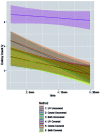A Practical Assessment of the Disinfectant Efficacy of UV Light with and without Ozone Using a Novel Transfer Hatch in a Research Animal Facility
- PMID: 35393007
- PMCID: PMC9137290
- DOI: 10.30802/AALAS-JAALAS-21-000131
A Practical Assessment of the Disinfectant Efficacy of UV Light with and without Ozone Using a Novel Transfer Hatch in a Research Animal Facility
Abstract
Most in vivo animal research and breeding using mice and rats in China takes place in facilities under barrier conditions. Items being moved across the barrier are typically disinfected using UV radiation in a transfer hatch. However, the time periods necessary for this disinfection technique are inefficient, and disinfection is frequently incomplete, especially if concealed surfaces are present. The current study used a newly developed transfer hatch incorporating both UV and ozone disinfection to examine disinfection efficacy against 4 bacteria species (Escherichia coli, Staphylococcus aureus, Pseudomonas aeruginosa, and Acinetobacter baumannii). Disinfection trials used UV and ozone, applied separately and in combination, for up to 30 min. Separate and combined treatments were also tested with a UV barrier. We found that if UV radiation has direct contact with surfaces, it is an efficient disinfection method. However, where surfaces are concealed by a UV barrier, UV radiation performs relatively poorly. The results of this study indicate that a combination of UV and ozone produces the most effective disinfection and is markedly quicker than current disinfection times for UV applied on its own. This novel transfer hatch design therefore allows more complete and efficient disinfection, improves workflow, and reduces barrier breaches by pathogens that may affect animal health and welfare and compromise research outcomes.
Figures




Similar articles
-
Combined ozone and ultraviolet inactivation of Escherichia coli.J Environ Sci Health A Tox Hazard Subst Environ Eng. 2006;41(6):1043-55. doi: 10.1080/10934520600620279. J Environ Sci Health A Tox Hazard Subst Environ Eng. 2006. PMID: 16760084
-
The efficacy of vacuum-ultraviolet light disinfection of some common environmental pathogens.BMC Infect Dis. 2020 Feb 11;20(1):127. doi: 10.1186/s12879-020-4847-9. BMC Infect Dis. 2020. PMID: 32046660 Free PMC article.
-
Effectiveness of a novel ozone-based system for the rapid high-level disinfection of health care spaces and surfaces.Am J Infect Control. 2011 Dec;39(10):873-9. doi: 10.1016/j.ajic.2011.01.012. Epub 2011 May 5. Am J Infect Control. 2011. PMID: 21546123
-
Recent advances in drinking water disinfection: successes and challenges.Rev Environ Contam Toxicol. 2013;222:111-70. doi: 10.1007/978-1-4614-4717-7_4. Rev Environ Contam Toxicol. 2013. PMID: 22990947 Review.
-
Control of microorganisms in flowing nutrient solutions.Adv Space Res. 1994 Nov;14(11):367-75. doi: 10.1016/0273-1177(94)90323-9. Adv Space Res. 1994. PMID: 11540207 Review.
References
-
- Chen LH, Li Y, Qi Y, Wang SN, Gao CQ, Wu Y. 2020. Evaluation of a pulsed xenon ultraviolet light device for reduction of pathogens with biofilm-forming ability and impact on environmental bioburden in clinical laboratories. Photodiagnosis Photodyn Ther 29:101544. 10.1016/j.pdpdt.2019.08.026. - DOI - PubMed
Publication types
MeSH terms
Substances
LinkOut - more resources
Full Text Sources
Medical

